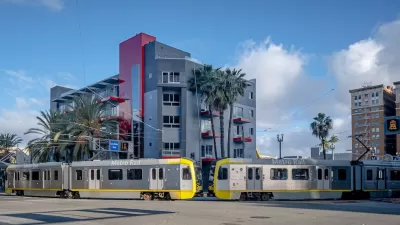In older, denser communities like Hoboken, NJ, where almost everything is walkable and land value is sky high, why are city officials still requiring parking minimums?

Andrew Price writes in Strong Towns about his frustration with the requirement that businesses in Hoboken, NJ are still required to provide a number of parking spaces, given the size, density and walkability of the city. Price argues that the space allocated for parking could be better use dto provide more housing.
…Hoboken is one of the few places in the United States where not owning a car does not feel like a hindrance. In fact, this was a major selling point for us, and probably for a lot of other people (because the rent is incredibly high which signifies that there is a lot of demand to live here.)
What was the discussion going on in city hall when they thought this was needed? Is it to compete with the suburbs? Real estate prices in Hoboken are extremely high, a sign that there is huge demand to live here. I chose to live here because it is not suburban, so why would we adopt policies that make our city more suburban? Why do we adopt ordinances that make most of our city's character illegal if we were to develop it from scratch today?
Doing some rough estimations on the cost to provide parking in Hoboken, Price notes that the cost to house a car (in a typical parking stall) is about $812.50 per month "if housing a car per square foot matched housing a person." In a city where affordable housing is desperately needed, Price asks why it should "cost a person 108x (per square foot) to house themselves over their car?"
FULL STORY: My Car Pays Cheaper Rent Than Me

Alabama: Trump Terminates Settlements for Black Communities Harmed By Raw Sewage
Trump deemed the landmark civil rights agreement “illegal DEI and environmental justice policy.”

Planetizen Federal Action Tracker
A weekly monitor of how Trump’s orders and actions are impacting planners and planning in America.

The 120 Year Old Tiny Home Villages That Sheltered San Francisco’s Earthquake Refugees
More than a century ago, San Francisco mobilized to house thousands of residents displaced by the 1906 earthquake. Could their strategy offer a model for the present?

In Both Crashes and Crime, Public Transportation is Far Safer than Driving
Contrary to popular assumptions, public transportation has far lower crash and crime rates than automobile travel. For safer communities, improve and encourage transit travel.

Report: Zoning Reforms Should Complement Nashville’s Ambitious Transit Plan
Without reform, restrictive zoning codes will limit the impact of the city’s planned transit expansion and could exclude some of the residents who depend on transit the most.

Judge Orders Release of Frozen IRA, IIJA Funding
The decision is a victory for environmental groups who charged that freezing funds for critical infrastructure and disaster response programs caused “real and irreparable harm” to communities.
Urban Design for Planners 1: Software Tools
This six-course series explores essential urban design concepts using open source software and equips planners with the tools they need to participate fully in the urban design process.
Planning for Universal Design
Learn the tools for implementing Universal Design in planning regulations.
Clanton & Associates, Inc.
Jessamine County Fiscal Court
Institute for Housing and Urban Development Studies (IHS)
City of Grandview
Harvard GSD Executive Education
Toledo-Lucas County Plan Commissions
Salt Lake City
NYU Wagner Graduate School of Public Service





























